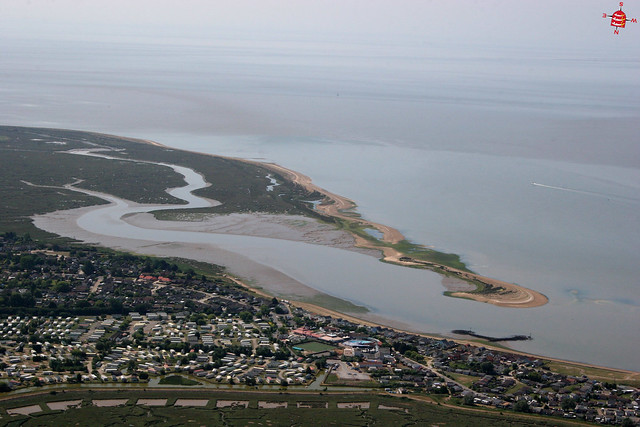For those of us who remember the dizzying excitement of learning about "longshore drift" and sand-spit formation from our school geography lessons, you might not realise unless you've walked as far west along the beach that Lee-Over-Sands and its geographical parent "Colne Point" features a great example of Sand-Spit formation.
 |
| This wonderful aerial photo is by Terry Joyce, looking from Point Clear, the sandpit can be seen curling round at the mouth of the Creek, opposite the Beach Cafe. |
While checking on the current status of our sea defences, I happened to find this interesting DEFRA article written by V.J.May about this changing coastal formation of Colne Point that some residents may find of interest.
One section worried me:
"It has, however, another role as part of the coast protection of the Essex coast. The level of the saltmarsh is higher than the land that lies landwards of the site behind artificial sea defences. The continuing efficacy of the sea defences depends upon the continued presence of the beach and saltmarsh. Unfortunately, the construction of groynes at the northern end of the site has substantially reduced the supply of sediment to the beach, which is now seriously affected by erosion. As a result, not only the natural importance of the site, but also its coast protection role, are threatened. If the sediment supply to the beach is not maintained, there is likely to be a deterioration of the proximal end of the beach, partial destruction of the saltmarshes and the sea-wall would become exposed. In these circumstances, it may prove prudent in the interest of maintaining the scientific interest to allow artificial beach-feeding by materials comparable to those that fed the beach in the past. The volume would need to be controlled so that it simulated the historical sediment transport patterns in magnitude and frequency. The coast protection needs would be furthered by such action. Like many sites on the English coast, the marsh and beach at St Osyth now depend upon human intervention for their future maintenance. The landward boundary is an artificial one (the sea-wall), without which the saltmarsh would by now have migrated well inland."
Click here to read the document in full
To add a more human element to the history of our area, I found out a few years ago that relative of my partner remembers that during the 1960s, Beach road's holiday homes were actually on the beach, rather than behind the large creek as they are now.

